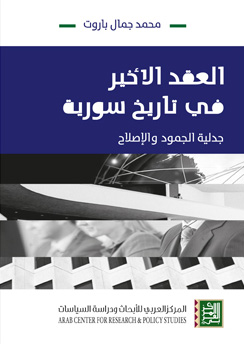 Book by ACRPS Researcher Mohammed Jamal Barout
Book by ACRPS Researcher Mohammed Jamal Barout
Published by the ACRPS in March 2012, The Last Ten Years in Syria: The Dialectic of Stagnation and Reform (462 pp.), written by Syrian, Doha-based writer and ACRPS staff researcher Mohammed Jamal Barout, examines the reality behind the revolution presently underway in the country. The book, a section of which is available in English on the ACRPS website, provides researchers and other interested readers with the background and footing in empirical data needed to comprehend how changes to Syria's political economy made the outbreak of the popular uprising on March 15, 2011 inevitable.
Addressing issues of political and social change, the book begins with an exhaustive history of the first decade of the 21st century and continues to examine in minute detail what the author calls "local community revolutions," set in small- and medium-sized towns and cities and in slums on the edges of other cities in Syria, which extended from February 19, 2011, the date of a major protest in Damascus' Hariqa District, until July 2011. Barout relies on data to compare and contrast between various forms of the geographically disparate Syrian revolution. For example, whereas the localized uprisings in the suburbs of Damascus, which culminated in a march to the city's Abassiya District, were largely peaceful, there were a number of armed raids led by the peasantry in rural villages against smaller towns. This latter characteristic was emblematic of the raids against Jisr al Shughor, Maaret Al Numaan, and Ariha. In researching these and other phenomenon, Barout attempts to identify and isolate the social and political actors who drove this wide-scale social movement, which in turn has given the Syrian revolution such resilience and staying power.
Barout's book is divided into two parts. First, an introduction to the cross-disciplinary approach the author adopts in understanding the relationship between development and social change, taking in political science, history, sociology, demography, and economics. In this section, Barout devotes a considerable amount of time to the debate which was held between those demanding liberalization of the Syrian economy and those demanding that it be "reformed" to return to its statist, socialist principles. Barout also pays close attention to the rising phenomenon of Syrian businessmen who drove the liberalization of Syria, leading to a situation he describes as "more growth, less development".
Click here to buy hard copies of ACRPS publications